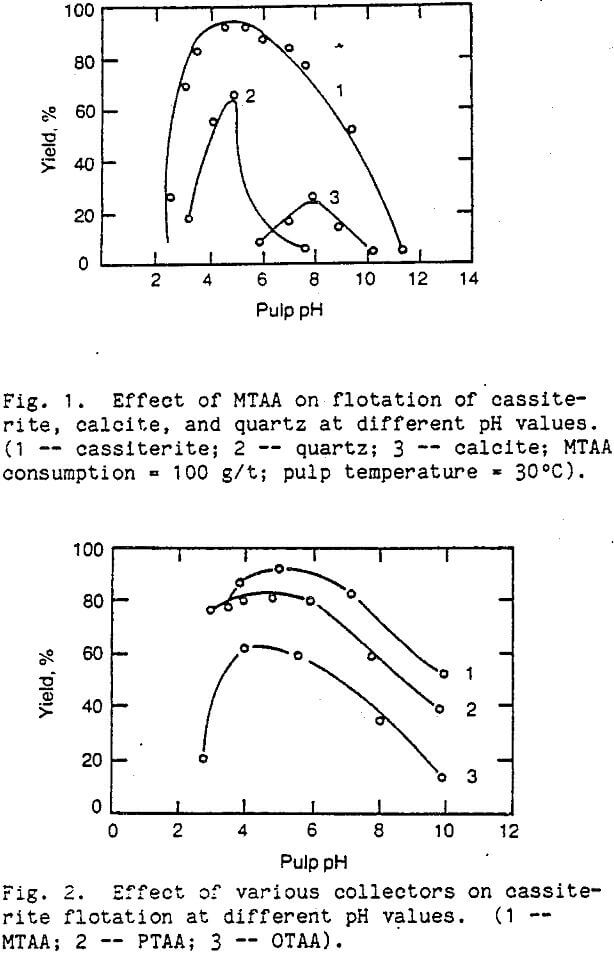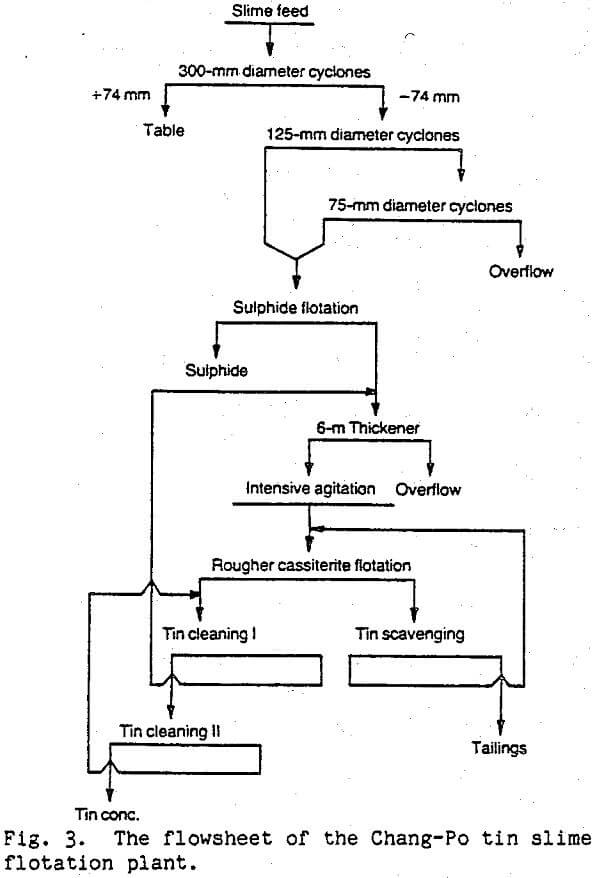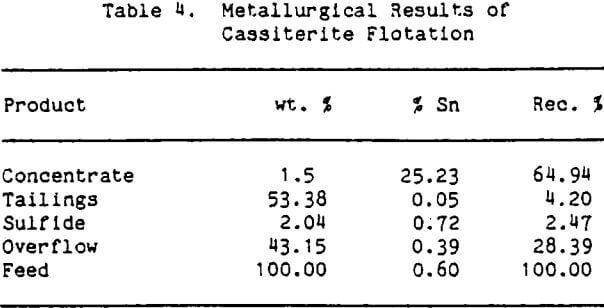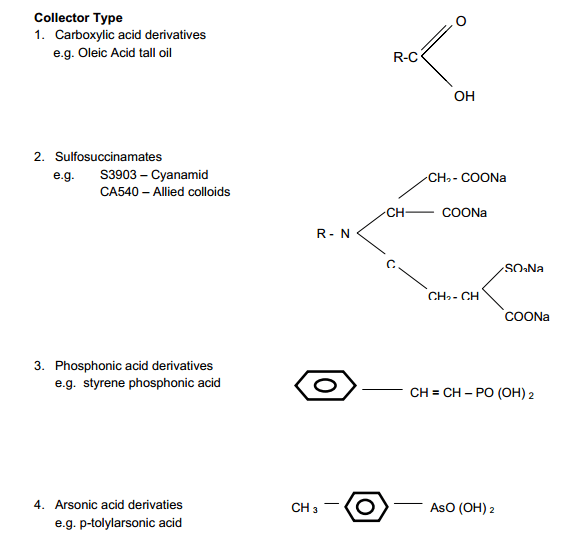The nominal size range for cassiterite flotation is between 2 and 100 microns. The top size is variable depending upon the liberation of the cassiterite particles. Cassiterite grains coarser than 100 microns are difficult to float whilst grains finer than 2 microns give selectivity problems. Hence the feed for cassiterite flotation should be reduced to 95% minus 100 microns and then deslimed at 2 microns to give a feed containing no more than 8% minus 2 microns.
When a number of tests are to be performed, a bulk sample of flotation feed is placed in a well agitated vessel (cyclone rig) at the required density for flotation and the required volume being sampled from the bulk for each test. This is to ensure consistency of the feed for each test, with regard to size distribution, grade and sample weight. It is important to have adequate sample for the number of tests required and to maintain the same sample quality, which will deteriorate with time.
When it comes to flotation of a Tin rich ore like cassiterite, collector is a most important reagent as it determines froth grade and recovery. The
optimum addition is controlled by several factors; ore type, head grade, product grade and recovery. The collectors used in cassiterite flotation often have an effect on the froth properties. Excessive collector additions can give froth properties. Excessive collector additions can give froth stability problems (bubbles too stable) and hence selectivity problems. The types of collectors used in the flotation of cassiterite are varied. A number of factors control the choice of collectors used. The following is a list of some of the collectors which are available:
A frother should be used with extra caution in oxide flotation as excessive amounts of frother will alter the froth composition, increasing the recovery of water and hence increase the recovery of the gangue minerals. The choice of frother for cassiterite flotation as recently become an important variable as the effects of various frother and concentrations have been investigated. The frother MIBC has historically been the frother used but recent limitations with this reagent have led to the use of alternatives such as Aerofroth 65, Senfroth 41G and Dowfroth 250.
Depressants
The reagent sodium silico fluoride (Na2SiF6) is the most commonly used depressant in cassiterite flotation, acting both as a slime dispersant and also reducing the floatability of certain minerals, especially fluorite, tourmaline and other silicates. It is also thought to activate cassiterite in some circumstances. This reagent is added prior to the collector addition, but further additions in the cleaning stages can be of benefit. The rate of
addition varies depending on the ore source, but 0.3-0.4 kg/tonne of feed is a good starting point.
Other depressants which are occasionally used are:
- Sodium silicate – slime dispersant but will depress cassiterite if added in large quantities
- Lignin sulphonate – depressant for gangue slimes;
- Cyquest – precipitation of heavy metal ions.
Modifiers:
It is necessary for the pH of the flotation pulp to be at the correct value and held relatively constant, for maximum selectivity and recovery.
Cassiterite flotation is nearly always performed in an acid environment, the exact value depending on the ore source and collector to be used. Sulphuric acid is used for pH adjustment in most cases. Changes in pH can cause changes to the froth. A reduction in pH will give better selectivity but usually at a lower recovery. If the pH is increased the opposite will occur as persistent froths are formed.
Alkali (NaOH)
The addition of NaOH is sometimes used to increase the pH in the cleaning stages. The higher pH helps in dispersing slime and improving the % Sn grade. Referred to mining chemicals handbook, by Cytec.
Flotation of Tin Ore Slimes
The sulphosuccinamates and arsonic or phosphonic acids are currently used on a commercial scale as cassiterite collectors in tin slime flotation. While the former type of collector has been used in conjunction with modifying agents such as citric acid and fluosllicate, phosphonic and arsonic acids are preferred in most plants with sodium silicate and fluosllicate as depressants. Common characteristics invariably found in all these flotation plants are careful desliming of the flotation feed and previous removal of the sulfide. It is generally considered that the arsonic or phosphonic acid are more selective than the sulphosuccinamates, but very complex tin ore still presents many difficulties. In view of difficulties en-countered in obtaining a sufficiently high selectivity, some new processes have been developed.
Direct Tin Flotation
Because ethylene phenyl phosphonic acid, sulphonated succinic acid, and oleic acid are more effective for calcite than for cassiterite, they are therefore unsuitable for cassiterite flotation from slimes which contain calcite as the main gangue mineral. Test results show that mixed tolyl arsonic acid (MTAA) is more selective as a collector for cassiterite than for calcite and quartz as shown in Fig. 1. The collecting power of three types of tolyl arsonic acid decreases in the order
MTAA > PTAA > OTAA
OTAA = ortho-tolyl arsonic acid, and PTAA = p-tolyl arsonic acid, as shown in Figure 2.

Tests have also indicated that sodium carboyl-methyl cellulose (CMC) is a more effective calcite depressant than sodium silicate, sodium fluosilicate, etc. CMC is a high molecular electrolyte. The function of CMC as a depressant for calcite is attributed to chemical adsorption by its carbonyl anion of calcium cations on the surface of calcite, the two hydroxyl groups of the glucose ring being hydrophilic. Furthermore, cassiterite flotation performance can be improved greatly by intensive agitation for 50 minutes prior to rougher flotation.
Adopting the aforementioned reagents and techniques, satisfactory results have been achieved in commercial operation of the Chang-Po cassiterite flotation plant. The run-of-mine ore is characterized by complex mineral composition, comprising cassiterite, pyrite, sphalerite, and pyrrhotite as the main valuable minerals, and calcite and quartz as the main gangue minerals. The major constituents in a typical slime sample are 0.58% Sn, 0.09% Pb, 0.19% Zn, 1.77% S, 0.13% As, 3.09% Fe, 3.93% CaO, and 15.20% SiO2. The minus 10-µm fraction in the slime accounts for 39.91% by weight with a tin content of 0.3% and metal distribution of 20.80%. The flowsheet of the Chang-Po flotation plant is shown in Fig. 3.

The slime from the gravity concentration plant is fed to 300-mm diameter cyclones. The underflow (+74 µm) reported back to the gravity concentrator, and the overflow (-74 µm) was sent to a series of 125- and 75-mm diameter cyclones to discard the minus 10-µm fraction (mainly composed of quartz). The -71 +10 µm size fraction reported to sulfide flotation, tailings from which were the cassiterite flotation feed. Results with the use of this flowsheet are given in Table 4.



